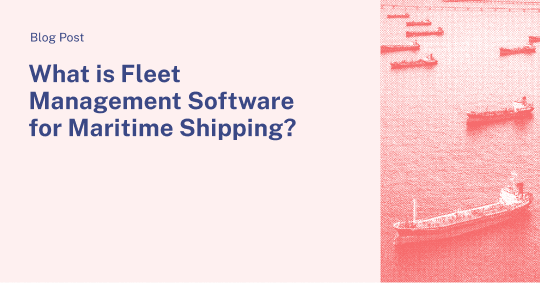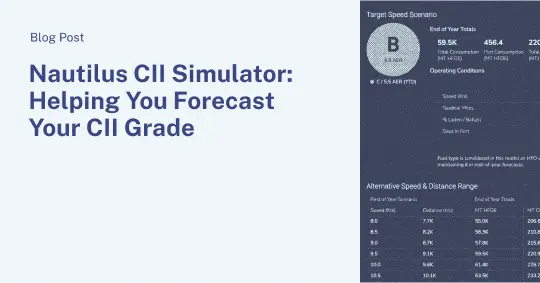The future: Shaping an industry around emissions
The emergence of big data and emissions regulations have become increasingly more important in the eyes of the shipowner and charterer. The accelerated adoption of data has given parties much greater access to information while the new emissions regulations are beginning to challenge commercial orientation. Starting now, digital adoption is shaping the groundwork for a new form of commercial agreement in emissions.
With sailing experience on Military Sealift Command vessels and working within an operations department at a large owner/operator, I noticed a lack of this digital adoption. In both cases, the respective teams continued to rely on daily reports sent/received in the form of excel files. Realizing and participating in this seemingly inefficient practice, I saw an opportunity to bring technology driven solutions to the Maritime Industry and joined Nautilus Labs.
The implementation of the new greenhouse gas regulations from the IMO in 2023 will change how the industry builds, plans, operates, and manages vessels in every segment and commercial orientation. To prepare for these new IMO regulations, Nautilus has the opportunity to empower owners/operators as leaders of digital transparency to drive new commercial arrangements. The principles built around these new commercial relationships will be driven by the environmental responsibility of owners and charterers in emissions.
Unfortunately, understanding the methodology owners and charterers must implement to reach and maintain compliance has been difficult. With the IMO aiming to cut CO2 emissions by 40% of 2008 levels by 2030, there are two short term emissions standards for existing vessels to meet in 2023. These include an Energy Efficiency Existing Ship Index (EEXI) and a Carbon Intensity Indicator (CII).
What do these emissions standards look like for owners and charterers:
- EEXI: Owners must ensure vessels meet a required emissions level given their type and capacity. The required emissions level will be considered the vessel’s baseline. To reach the required level, the vessel must lower its attained (realized) emissions level through alterations to the vessel’s design and/or machinery. This indicator does not include any aspects of operational emissions reductions.
- CII: Owners/Charterers will determine annual emissions to show continuous improvement of operational emissions reductions. A rating scale ranging from grades A-E will be used to indicate the vessel’s CII performance levels. The rating scale will become more stringent towards 2030. For vessels that receive a D rating for three consecutive years or a single E rating, corrective action must be taken as part of a SEEMP (Ship Energy Efficiency Plan). Fuel efficiency, weather routing, propeller/hull cleaning, speed optimization, and generator optimization will all be needed to effectively reduce emissions year over year.
Digitalization of owner/charterer relationships: Sharing responsibility in emissions reduction
Digitalization has presented advantages and challenges felt by both owners and charterers across the industry. One of the main advantages is the potential for analysis and optimization of vessel related metrics when based on high frequency sensor data. The challenge sits with inefficient (data-driven) decision making and data silos that come from the use of too many digital tools and poor data sets. This stands even truer in terms of the limited data sharing capabilities built into chartering agreements.
Transforming the digital relationship between owner and charterers is not a new concept at Nautilus Labs. In the past, we have brought together multiple parties by using high frequency sensor data analysis to benefit all stakeholders environmentally and commercially. Looking out on the horizon, 2023 will begin the implementation and required adherence of the CII, and we believe could be the catalyst that sparks deeper digital collaboration within commercial agreements.
It has become clear that from a commercial standpoint, operating restrictions and emissions caps required by CII will ultimately change how owners and charterers approach voyage planning and vessel optimization. The responsibility for maintaining required emissions and ensuring a high CII rating, carries over to both owners and charterers, forcing a need for collaboration. Adopting a digital interface to track, monitor, and optimize emissions for a vessel will be the catalyst needed to drive a new commercial arrangement. The addition of a digital solution that can help mitigate emissions through optimization all the while monitoring commercial opportunity of operational decisions, will help to ensure vessel adherence without negatively impacting their CII rating.
Nautilus Labs: The digital solution to emissions reduction through collaboration
EEXI is not the only consideration owners and charterers can depend on to reach an effective emissions solution. Continuous improvement of emissions year over year for CII cannot be met if the only preventative action is to modify the existing vessel. Alone, it is not enough to solve the issue of proving a substantial decrease in greenhouse gases. Operational efficiency will be king in regards to CII. Owners and charterers will be required to run their ships in the most optimal configuration, ensuring maintenance/degradation to hull and propeller are kept to a bare minimum, operators are optimizing for generator configuration and fuel consumption, and the vessel is being routed for the effects of weather while keeping commercial consumptions and emissions to a minimum. Owners and charterers must rely on other operational measures to meet the required emissions levels. The most effective way to ensure vessels are meeting these requirements is by adopting a digital solution, where collaboration between parties is required. This is where the Nautilus Platform shines.
At Nautilus, we build a holistic picture of the vessel using high frequency sensors, noon reports, operational, technical, commercial, environmental, and weather data. Leveraging an approach to big data, we can provide the operational, technical, and commercial support needed to drive compliance towards these new regulations. Taking advantage of machine learning-based high frequency sensor data analysis, our platform unlocks the ability to track emissions improvements through speed, generator, and performance optimization. Nautilus gives real time insights into the amount and type of emissions all the while giving owners and charterers a greater understanding of what to expect from a CII perspective.
Whether it be through vessel performance or generator configuration and load, Nautilus can help owners and charterers best optimize their vessels environmentally and commercially.
To learn more about how Nautilus can transform your available vessel data into actionable recommendations that drive significant emissions insight, please contact us at sales@nautiluslabs.com.


